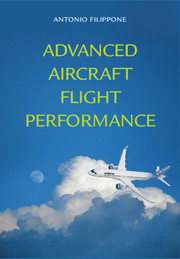Book contents
- Frontmatter
- Contents
- Tables
- Preface
- Nomenclature
- Technology Warning
- 1 Prolegomena
- 2 Aircraft Models
- 3 Weight and Balance Performance
- 4 Aerodynamic Performance
- 5 Engine Performance
- 6 Propeller Performance
- 7 Airplane Trim
- 8 Flight Envelopes
- 9 Take-Off and Field Performance
- 10 Climb Performance
- 11 Descent and Landing Performance
- 12 Cruise Performance
- 13 Manoeuvre Performance
- 14 Thermo-Structural Performance
- 15 Mission Analysis
- 16 Aircraft Noise: Noise Sources
- 17 Aircraft Noise: Propagation
- 18 Aircraft Noise: Flight Trajectories
- 19 Environmental Performance
- 20 Epilogue
- Appendix A Gulfstream G-550
- Appendix B Certified Aircraft Noise Data
- Appendix C Options for the FLIGHT Program
- Index
- References
8 - Flight Envelopes
Published online by Cambridge University Press: 05 January 2013
- Frontmatter
- Contents
- Tables
- Preface
- Nomenclature
- Technology Warning
- 1 Prolegomena
- 2 Aircraft Models
- 3 Weight and Balance Performance
- 4 Aerodynamic Performance
- 5 Engine Performance
- 6 Propeller Performance
- 7 Airplane Trim
- 8 Flight Envelopes
- 9 Take-Off and Field Performance
- 10 Climb Performance
- 11 Descent and Landing Performance
- 12 Cruise Performance
- 13 Manoeuvre Performance
- 14 Thermo-Structural Performance
- 15 Mission Analysis
- 16 Aircraft Noise: Noise Sources
- 17 Aircraft Noise: Propagation
- 18 Aircraft Noise: Flight Trajectories
- 19 Environmental Performance
- 20 Epilogue
- Appendix A Gulfstream G-550
- Appendix B Certified Aircraft Noise Data
- Appendix C Options for the FLIGHT Program
- Index
- References
Summary
Overview
This chapter deals with flight envelopes in the speed-altitude space. We present various atmospheric models (§ 8.1), standard as well as non-standard. We give several operating air speed definitions (§ 8.2), as well as design speeds (§ 8.3) and the techniques required to measure them. For the steady-state level flight we derive two optimal conditions: minimum drag and minimum power (§ 8.4). We discuss the flight corridors at constant altitude and the ceiling performance airplanes (§ 8.5). We discuss the flight envelopes of subsonic transport aircraft and their limitations (§ 8.6), including the effects of the cabin pressure. We conclude the chapter with flight envelopes at supersonic Mach number (§ 8.7), including dash speed, supersonic accelerations and propulsion limitations.
KEY CONCEPTS: International Standard Atmosphere, Atmosphere Models, Operating Speeds (EAS, CAS, TAS), Transition Altitude, Design Speeds, Optimum Level Speeds, Ceiling Performance, Cabin Pressure, Flight Envelopes, Supersonic Dash, Supersonic Acceleration.
The Atmosphere
Most performance calculations are done with a conventional atmosphere that has been declared standard (§ 8.1.1), although the almost totality of flights take place in far more complex atmospheres, with variation in the thermodynamic properties in both the vertical and horizontal directions. To overcome the limitations of the standard model, alternative atmosphere models are available to take into account extreme temperatures (very hot and very cold), as explained in § 8.1.2. The effect of air humidity is generally neglected in aerodynamics and engine performance, although it is important for other aspects, such as noise propagation.
- Type
- Chapter
- Information
- Advanced Aircraft Flight Performance , pp. 195 - 223Publisher: Cambridge University PressPrint publication year: 2012
References
- 1
- Cited by



